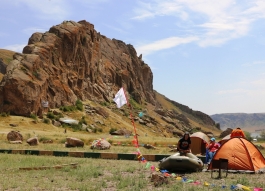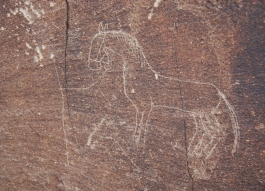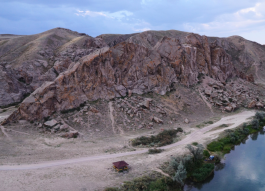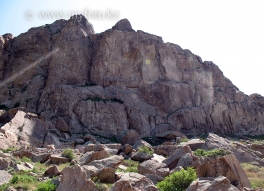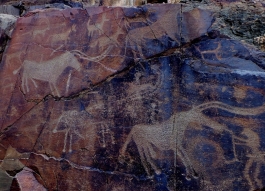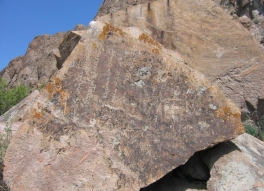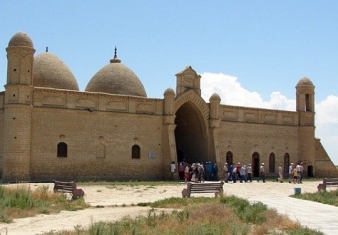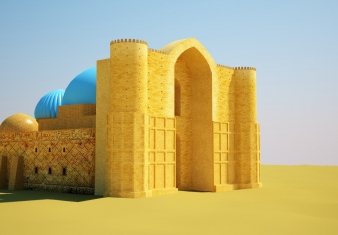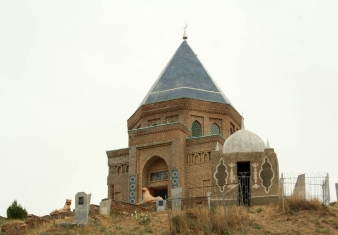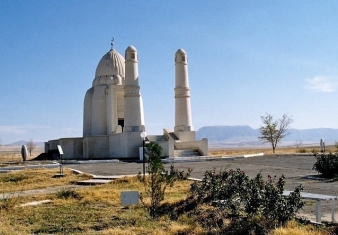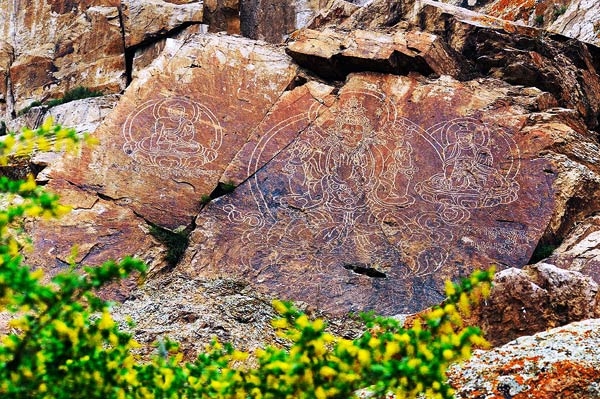
 Holy places
Holy places
44.0613076, 76.9962018
The Tamgaly Tas is an area near the river of Ili located in 120 kilometers to north from the city of Almaty (in 20 kilometers south of the Kapchagai reservoir by the road to Bakanas) where were saved various petroglyphs and images of mysterious idols and late Buddhist inscriptions.
There were saved nearly 1000 various images on the rocks. Apart from the Buddhist images and inscriptions, there is one ancient Turkic runic inscription of 8th-9th centuries presumably carved by the Kipchaks. The Buddhist images date back to approximately 14th – 16th centuries.
The composition consists of five images and writings placed on three big rocks. The images are carved in accordance with the canons that were largely distributed and saved for a very long time. Inscriptions and text placed next to each other have not been translated yet. Several writings can be read was prayerful formula “mani padme hum”.
The features of the inscriptions state that this image was created earlier than the main site. The setup of the interior complies with the overall concept of the temple. Walking through big stones a person finds himself in front of a separate stone with the image of Buddha with snakes.
In traditions of South-Eastern Asia, such frightening images fence off evil spirits and do not let in people with evil thoughts. Only waking through the Buddha a person can come up to the center of the site.
Among all images of Tamgaly-Tas, the most famous ones are three images of the Buddha. The first one is bodhissatva (an animal or person in Buddhism which decided to become a Buddha for the sake of all animals) Avalokiteshvara with a height of 2,5 meters. It sits in a diamond pose on the lotus flower with four hands. The front hand is folded for prayer, he holds a crystal string of beads with the right rear hand, in the left hand, there is a lotus flower with a long stalk.
On the right of it in four meters height there is Shakyamuni Buddha with the size of 1 meter and with following inscription “I worship the Shakyamuni Buddha”. On his left hand, there is a cup for alms. The right hand is lowered with palm to itself. This gesture calls Earth to witness. There is Amitabha Buddha (the most respected figure in the Pure Land Buddhism) on the left side.
The size of the image is also 1 meter. It sits on the throne of lotus and holds a casket filled with remedy nectar in the left hand. Lowered right hand with palms to spectators with the gesture of return holds fruit of Golden myrobalan. This plant is an Indian almond, a pagoda-tree, a king of all remedy preparations from psychic and physical illnesses. There is an inscription: “I worship for Buddha Mahayana”.
There are several versions of how these images were created in the banks of the river of Ili. According to one of the legends, in the 10th century, one of the Buddhist missions stayed on the banks of the river of Ili during a trip to the region of Semirechye an earthquake took place and a big piece of rock fell. That was assumed as a sign to return to India.
Three images of Buddha were carved on the split off the rock. According to another version, the inscriptions were made by the Kalmyks on “todorkhoi nomyn bichig” (“clean literature letter”), that was created by Zae Pandita Ogtorguin in 1648 and was used more than three centuries by the nomad Mongols who carved the images of Buddha.
The first serious explorations in the gauge of Tamgaly were conducted by Chokan Valikhanov. In 1856 he was there and thoroughly described them. In the end of the 19th century N.N.Pantusov, scientist, and orientalist, conducted detailed research of the images of Buddha. He defined the ages of the images in accordance with the surnames of historical persons mentioned in the inscriptions.
They were carved nearly 500 years ago during “Tibet invasion”. In the 70s of the 20th century, the inscriptions and images of the Tamgaly-Tas were explored by A.K.Margulan, well known Kazakh archeologist. He could systematize existing translations of the inscriptions. He expressed assumption about Junggar origin of the whole composition and stated that the monument dated back to the 17th-18th centuries.
Arystan Bab Mausoleum is a mausoleum in Kazakhstan close to the village of Kogam and Otrartobe.

The Aisha-Bibi is in the west of Taraz, Kazakhstan on the Silk Road. It is locally famous as a monument to love and faithfulness.
The religious structure continues to draw pilgrims from across Central Asia and has come to epitomize the Kazakh national identity.
Baydibek Karashauly (dates of birth and death are unknown) lived in the 11-12th centuries in the neighborhood of East Karatau, died in present Algabas district, near Aktas stud and buried on the river bank of Balabogen. The tomb established still in the ancient time with a dome remained.
Domalak Ana Mausoleum is a unique architectural monument of the South Kazakhstan.
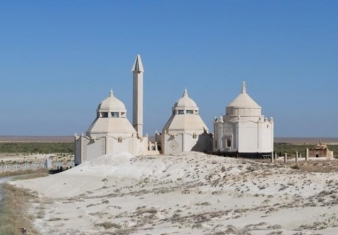
Beket-Ata Underground mosque is located in the Oglandy countryside, Mangystau region. This religious monument of architecture dates back to the XVIII century. Beket-Ata is considered as a holy place, in importance as a burial of Khozha Ahmed Yassaui. During two centuries, pilgrims come here for bowing the Holy Spirit.














